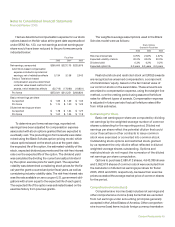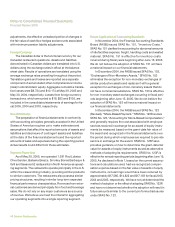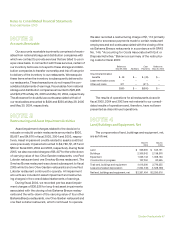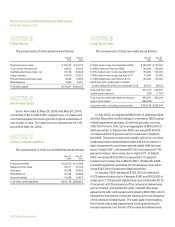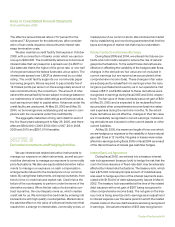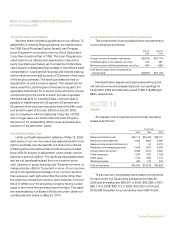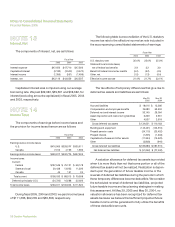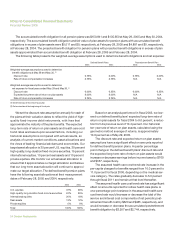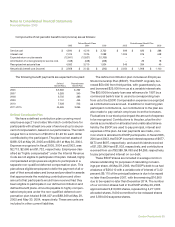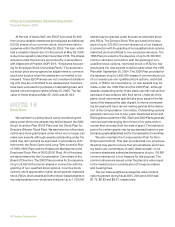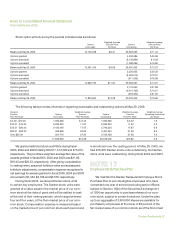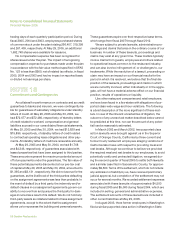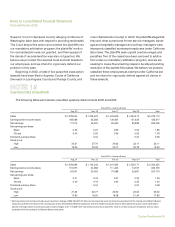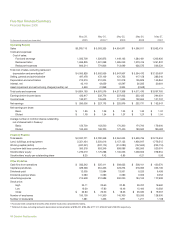Red Lobster 2005 Annual Report Download - page 46
Download and view the complete annual report
Please find page 46 of the 2005 Red Lobster annual report below. You can navigate through the pages in the report by either clicking on the pages listed below, or by using the keyword search tool below to find specific information within the annual report.
Notes to Consolidated Financial Statements
Financial Review 2005
54 Darden Restaurants
The accumulated benefit obligation for all pension plans was $150,841 and $135,950 at May 29, 2005 and May 30, 2004,
respectively. The accumulated benefit obligation and fair value of plan assets for pension plans with accumulated benefit
obligations in excess of plan assets were $5,011 and $0, respectively, at February 28, 2005 and $4,881 and $0, respectively,
at February 28, 2004. The projected benefit obligation for pension plans with projected benefit obligations in excess of plan
assets approximated their accumulated benefit obligation at February 28, 2005 and February 28, 2004.
The following table presents the weighted-average assumptions used to determine benefit obligations and net expense:
Defined Benefit Plans Postretirement Benefit Plan
2005 2004 2005 2004
Weighted-average assumptions used to determine
benefit obligations at May 29 and May 30,
(1)
Discount rate 5.75% 6.00% 5.75% 6.00%
Rate of future compensation increases 3.75% 3.75% N/A N/A
Weighted-average assumptions used to determine
net expense for fiscal years ended May 29 and May 30,
(2)
Discount rate 6.00% 6.25% 6.00% 6.25%
Expected long-term rate of return on plan assets 9.00% 9.00% N/A N/A
Rate of future compensation increases 3.75% 3.75% N/A N/A
(1) Determined as of the end of fiscal year
(2) Determined as of the beginning of fiscal year
We set the discount rate assumption annually for each of
the plans at their valuation dates to reflect the yield of high-
quality fixed-income debt instruments, with lives that
approximate the maturity of the plan benefits. The expected
long-term rate of return on plan assets and health care cost
trend rates are based upon several factors, including our
historical assumptions compared with actual results, an
analysis of current market conditions, asset allocations and
the views of leading financial advisers and economists. Our
target asset allocation is 35 percent U.S. equities, 30 percent
high-quality, long-duration fixed-income securities, 15 percent
international equities, 10 percent real assets and 10 percent
private equities. We monitor our actual asset allocation to
ensure that it approximates our target allocation and believe
that our long-term asset allocation will continue to approxi-
mate our target allocation. The defined benefit pension plans
have the following asset allocations at their measurement
dates of February 28, 2005 and 2004, respectively:
2005 2004
U.S. equities 37% 38%
High-quality, long-duration fixed-income securities 24% 26%
International equities 20% 18%
Real assets 13% 12%
Private equities 6% 6%
Total 100% 100%
Based on an analysis performed in fiscal 2003, we low-
ered our defined benefit plans’ expected long-term rate of
return on plan assets for fiscal 2004 to 9.0 percent, a reduc-
tion from its previous level of 10.4 percent. Our historical
ten-year rate of return on plan assets, calculated using the
geometric method average of returns, is approximately
10.9 percent as of May 29, 2005.
The discount rate and expected return on plan assets
assumptions have a significant effect on amounts reported
for defined benefit pension plans. A quarter percentage
point change in the defined benefit plans’ discount rate and
the expected long-term rate of return on plan assets would
increase or decrease earnings before income taxes by $769
and $357, respectively.
The assumed health care cost trend rate increase in the
per-capita charges for benefits ranged from 10.0 percent to
11.0 percent for fiscal 2006, depending on the medical ser-
vice category. The rates gradually decrease to 5.0 percent
through fiscal 2011 and remain at that level thereafter.
The assumed health care cost trend rate has a significant
effect on amounts reported for retiree health care plans. A
one-percentage-point variance in the assumed health care
cost trend rate would increase or decrease the total of the
service and interest cost components of net periodic post-
retirement benefit cost by $620 and $485, respectively, and
would increase or decrease the accumulated postretirement
benefit obligation by $3,507 and $2,744, respectively.



